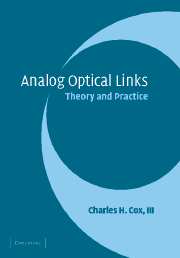6 - Distortion in links
Published online by Cambridge University Press: 08 August 2009
Summary
Introduction
In Chapter 5 we explored one type of extraneous signals in links – noise – that because of its random nature is characterized byits statistical properties. In this chapter we investigate the other type of extraneous signals in links– distortion. Unlike noise however, distortion signals are deterministic. A further distinctionbetween noise and distortion is the fact that while noise is always present, independent ofwhether there are any signals present, distortion is only present when at least one signal is present. We continue in this chapter a theme of this book by using one model to describe the distortionof both direct and external modulation, although the detailed nature of the distortion will dependon the particular modulation method that is used.
The discussion that begins this chapter is general in that the results apply to all devices with some non-linearity. The general results include the frequencies at which distortionproducts occur, the measures of distortion and the conversions among them. We then apply thesetools to the characterization of the distortion produced by the modulation and photodetection devicesthat we have been studying throughout this book. For some applications the distortion levels areunacceptably high. This has led to the development of a variety of linearization techniques. The chapterconcludes with an examination of two linearization techniques.
An optical link as defined in this book consists of linear passive electrical andoptical components as well as modulation and photodetection devices.
Information
- Type
- Chapter
- Information
- Analog Optical LinksTheory and Practice, pp. 201 - 262Publisher: Cambridge University PressPrint publication year: 2004
References
Accessibility standard: Unknown
Why this information is here
This section outlines the accessibility features of this content - including support for screen readers, full keyboard navigation and high-contrast display options. This may not be relevant for you.Accessibility Information
- 5
- Cited by
